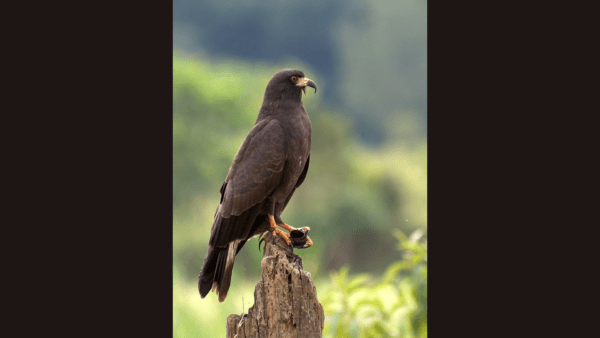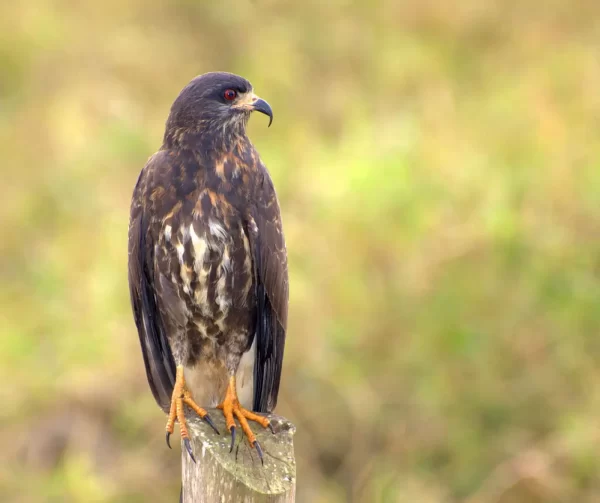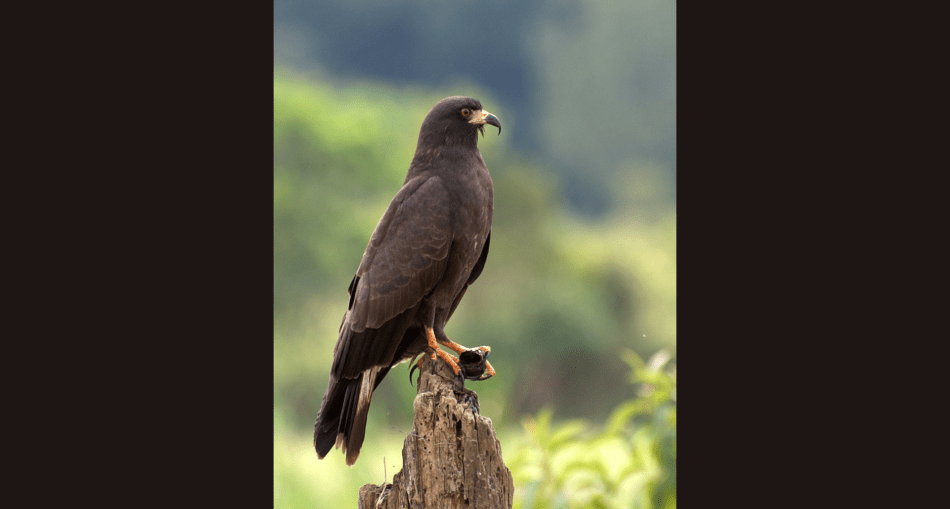The snail kite (Rostrhamus sociabilis) is a striking bird of prey found in the wetlands of Guyana.

The snail kite [Photo: Dario Sanches]
PHYSICAL FEATURES OF THE SNAIL KITE
Measuring 36 to 48 cm (14 to 19 inches) in length with a wingspan of 99 to 120 cm (39 to 47 inches), the snail kite is a medium-sized bird with a sleek, elegant build.
Its long, broad wings and long tail make it well-suited for manoeuvring over wetlands. The bird’s most distinctive feature is its dark, deeply hooked beak, perfectly adapted for extracting apple snails from their shells.
Adult males sport dark blue-grey plumage with darker flight feathers and bright red legs and cere (the area around the beak). Females have darker brown upper parts and pale, streaked underparts with yellow or orange legs and cere. Juveniles closely resemble the adult female but have a streaked crown.
FUN FACT: It is closely related to the slender-billed kite, which is now placed in a separate genus.
DIET AND HUNTING BEHAVIOUR
The snail kite is a molluscivorous that primarily feeds on snails. It hunts them by flying slowly over water with its head tilted downward.
This bird has a remarkable method of extracting snails from their shells. Using its curved bill, it cuts through the muscle that attaches the snail to its shell, allowing the kite to swallow the mollusc whole.

Photo: Claudney Neves
Although snails make up the bulk of its diet, the snail kite is known to consume other aquatic prey, such as crayfish, turtles, and occasionally small fish and rodents, especially when its primary food source is scarce.
HABITAT AND DISTRIBUTION IN GUYANA
The snail kite thrives in wetland habitats such as freshwater marshes, swamps, and lakes, all of which are abundant in Guyana.
These areas provide the ideal environment for the bird to hunt and nest. In Guyana, as well as other parts of tropical South America, the snail kite is resident year-round, although some populations migrate.
BREEDING AND NESTING
Snail kites typically nest in bushes or on the ground near water. The female lays three to four eggs, which both parents incubate for about a month.
After hatching, the chicks are dependent on their parents for food for up to two months. They become independent by the second month and may reach reproductive maturity by the first year.
The snail kite’s mating system remains somewhat mysterious. Still, it is known that females sometimes leave their mates in the middle of the breeding season to find new partners, potentially increasing their chances of producing additional clutches within the year.
CONSERVATION AND POPULATION TRENDS
In Guyana, the snail kite is not generally at risk, as its habitat remains largely intact.
The snail kite is listed as “Least Concern” by the IUCN Red List, and its population is estimated at two million individuals worldwide, with numbers on the rise in several areas.
FUN FACT: During courtship, the snail kite produces sounds that resemble a sheep’s bleating.
REFERENCES
- https://en.wikipedia.org/wiki/Snail_kite
- https://animalia.bio/snail-kite?environment=110
- https://www.iucnredlist.org/species/22695048/93487191







